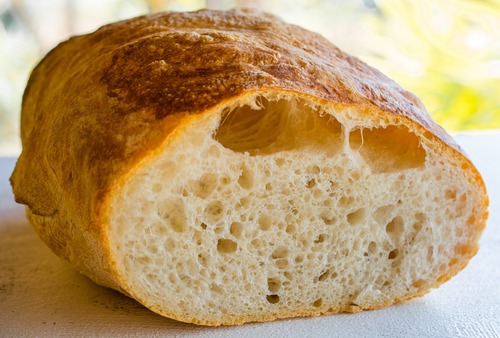Is White Bread Bad For You?
Short answer
White bread is not good for you and should be eaten in moderation if not avoided entirely.
Recommended Alternative
Category 'F' is for things that fail to bring anything beneficial to the table, and are very harmful to your health. We recommend completely avoiding anything in this category. Long-term side effects of 'F' items are usually very serious.
View Full Grading System
Category 'A'
Very healthy and numerous health benefits. Side effects are rare. Things rated an 'A+' are typically necessary for survival (for example, water).
Very healthy and numerous health benefits. A few harmful qualities may be associated, but only under certain circumstances such as an allergic reaction.
Very healthy and numerous health benefits. Harmful qualities may be associated, but aren't usually serious.
It is important to note that even the best things in life can become bad in immoderate amounts. So, although something may be rated an 'A+', overconsumption/overdoing can bring unwanted effects.
Category 'B'
Very beneficial to your health. Things rated a 'B+' may have a few harmful qualities to pay attention to.
Overall beneficial to your health. Things rated a 'B' may have some harmful qualities to pay attention to.
More beneficial to your health than not. However, harmful qualities are most likely associated and shouldn't be overlooked.
The main difference between category 'A' and category 'B' is the harmful qualities typically present in 'B' items. Serious side effects are usually uncommon, but are still possible and should be taken note of.
Category 'C'
Both beneficial and harmful qualities associated. Things rated a 'C+' are typically a bit more on the beneficial side. Still, moderation is important.
A fairly even ratio of beneficial and harmful qualities. Moderation is important. Very general topics that can lean towards both sides of the spectrum will be placed here as well. Rice, for example, can be good or bad depending on the type.
More harmful than beneficial. Side effects are common, especially when consumed/done excessively. Moderation is very important.
Category 'C' usually denotes to both good and bad qualities. When it comes to this category, it is important to keep this word in mind: moderation.
Category 'D'
Harmful to your health. Although benefits may be associated, the bad most likely outweighs the good. Moderation is very important.
Harmful to your health. A few benefits may be associated, but the bad outweighs the good. Moderation is extremely important.
Harmful to your health. Very few, if any, benefits are present. Things in this category should be avoided as much as possible.
Category 'D' is typically for things that are more harmful than beneficial. While consuming/doing something unhealthy once in a blue moon shouldn't hurt, we definitely recommend eliminating 'D' items as a regular part of your routine/diet.
Category 'F'
Category 'F' is for things that fail to bring anything beneficial to the table, and are very harmful to your health. We recommend completely avoiding anything in this category. Long-term side effects of 'F' items are usually very serious.
Category 'N'
'N' stands for neutral. Things placed into this category are generally (a) neither good nor bad for you, or (b) lack the necessary evidence to reach any conclusions.
Long answer
There are thousands of foods that have become a mainstay in people's diets and white bread is one. Whether it is used for a peanut butter and jelly sandwich, grilled cheese or french toast, people often reach for white bread when they go grocery shopping every week. While white bread tastes good and is consumed by many, it is a food that people may fail to completely understand.
When it comes to white bread, there are many reasons eat less or avoid it all together. White bread is made from refined grains, a process in which the bran and germ are removed from the grain eliminating many essential nutrients. In fact, large amounts of vitamin E, calcium, fiber, phosphorus, and iron are completely destroyed.
In most cases, the flour also goes through a bleaching process. Chemicals such as potassium bromate, azodicarbonamide, and chlorine dioxide are used to further whiten the bread. Some bleaching agents have been banned from certain countries, as they are known to cause diabetes, asthma, and even tumors in the kidneys.
Furthermore, white bread is one of the foods highest on the glycemic index. This means, when compared to other foods, it has the potential of spiking blood sugar to extremely high levels after consumption. Blood sugar spikes are commonly known to increase the risk of hyperglycemia, the condition that often shows prior to diabetes, and includes symptoms such as blurred vision, frequent urination, fatigue, headache, and increased thirst / hunger. If blood sugar continues to stay "too high" nausea, weakness, confusion, and abdominal pain may begin to arise.
Possible long-term side effects
- obesity
-
asthma
-
tumors
-
hyperglycemia
-
diabetes
-
celiac disease
Ingredients to be aware of
Benefits
Healthier alternatives
Our Wellness Pick
(what is this?)
Dave’s Killer Bread
- Organic ingredients
- 21 whole grains/seeds
- High in fiber
- Non-GMO
- 27 oz loaf
Learn More!
Please turn your Ad Blocker off to see this content. Thank you!
Thank you for your feedback!
Written by Healthy Living 35
Published on: 12-29-2015
Last updated: 12-15-2023
Thank you for your feedback!
Written by Healthy Living 35
Published on: 12-29-2015
Last updated: 12-15-2023

 Approved by
Approved by 















